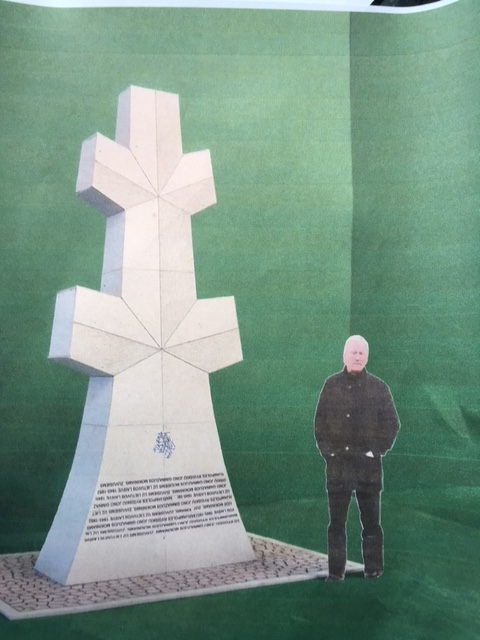Ald. Aram Ayalon (D-3), who had been opposing plans for a monument to Lithuanian militant Adolfas Ramanauskas in Walnut Hill Park, received word from the office of Republican Mayor Erin Stewart that the plans will not be moving forward.

Ayalon received word on Friday from Stewart ‘s office that Ramanauskas will not be honored with a monument. “They canceled!,” he said.
“Mr. Ramanauskas’ background indicates he was a leader of a paramilitary organization in a town in Lithuania in 1941 which was involved in killing Jews before even the Nazis took over,” said Ayalon. “While there is no evidence of him actually killing Jews, there is sufficient evidence not to create a monument for him in New Britain. Erecting a monument to him would be an offense to many Jews and non-Jews in Connecticut.”
Ayalon added that, “The government of Lithuania has been involved on a continuous basis in suppressing holocaust involvement of Lithuanians. Research shows that 96% of all Lithuanian Jews perished in the Holocaust, higher percentage than any other country including Germany, because of local collaboration with the Nazis.”
Stewart had met with the Speaker of the Lithuanian parliament in June of 2017, who, after visiting U.S. officials in Washington, DC, “wanted to stop by New Britain to discuss the construction of a monument in New Britain to honor,” Ramanauskas. On December 15, 2017, the Parks and Recreation Commission approved allowing the government of Lithuania to, “install a Lithuanian Monument in Walnut Hall Park.”
In January, 2018, the website, “Defending History,” edited by Professor Dovid Katz, questioned the planned New Britain monument to Ramanauskas, saying it sent a letter to Stewart, “to ask if her team was aware of the alleged pro-Nazi and Holocaust collaborator background of a Lithuanian militant, Adolfas Ramanauskas.” The website said,
Ramanauskas boasted in his own memoirs of leading a “partisan group” in late June 1941, and there is certainly nothing in that memoir expressing any regret over what those “partisan groups” did. They murdered and humiliated Jewish neighbors while blocking roads and circling towns to ensure that Jewish citizens could not escape the Nazi choke-hold.
 Ayalon only recently became aware of the planned monument and introduced City Council petition requesting, “a temporary halt of the building of a monument to commemorate Lithuanian militant, Adolfas Ramanauskas, until further research has been conducted to help confirm the history behind the man being memorialized.”
Ayalon only recently became aware of the planned monument and introduced City Council petition requesting, “a temporary halt of the building of a monument to commemorate Lithuanian militant, Adolfas Ramanauskas, until further research has been conducted to help confirm the history behind the man being memorialized.”
Ramanauskas was born in New Britain to a Lithuanian family in 1918. He is widely considered a national hero in Lithuania because of his leadership in partisan fighting against the Soviet Union after World War II. He was known by the code name Vanagas or “Hawk.” Chicago-based Draguas News referred to Ramanauskas as, “One of the last and best known commanders of Lithuanian armed resistance to Russian occupation.” He was captured by the KGB, was tortured and was executed in 1957. Ramanauskas was given numerous official honors after Lithuania became independent from the Soviet Union in 1990, and the Lithuanian parliament, called the Seimas, dedicated 2018 in his honor.
But, it is Ramanauskas’ role as a leader of a partisan unit early in World War II that is at issue.
As the United States Holocaust Memorial Museum describes that moment in history, when the Germans invaded the Soviet Union in 1941 and moved their forces into Lithuania,
The Lithuanians carried out violent riots against the Jews both shortly before and immediately after the arrival of German forces. In June and July 1941, detachments of German Einsatzgruppen (mobile killing units), together with Lithuanian auxiliaries, began murdering the Jews of Lithuania. By the end of August 1941, most Jews in rural Lithuania had been shot.
Katz, who lives in Lithuania, told Ayalon that Ramanauskas,
was the LEADER of one of these marauding bands of Hitlerist murderers who were killing Jews up and down the country in the days BEFORE the Germans got there. If there was any evidence of what he “personally did” that week it is gone, but the view of all good men and women here is that anyone who volunteered to LEAD one of those murderous groups in June 1941, and then bragged about it in his memoirs, without the slightest word of regret about what happened to his town’s Jewish minority is not necessarily a criminal but is certainly NOT a hero! Indeed, the particular unit Ramanauskas led was responsible for dozens of murders of “Jews and Communists” during the early weeks.
The Simon Wiesenthal Center’s Director for Eastern Europe, Holocaust historian Dr. Efraim Zuroff, had urged the Lithuanian Seimas not to name 2018 in Ramanauskas’ honor. The Wiesenthal Center said that Ramanauskas was, “was the leader of the local Nazi collaborators in the town of Druskininkiai in southern Lithuania, who persecuted the Jews of that community during the initial weeks following the Nazi invasion of June 22, 1941.”
In a March 30, 2018 article, the New York Times, reported on the history of the Holocaust in Lithuania and the current politics about it in that country.
Editor’s note (12/26/2018): The article was updated to correct that Stewart said that it was, specifically, the Speaker of the Lithuanian Parliament who wanted to discuss the monument. Her quote said that she also met with the Consul General of Lithuania in New York, but not that he had advocated for the monument, as the article previously said. Apologies for the error.



